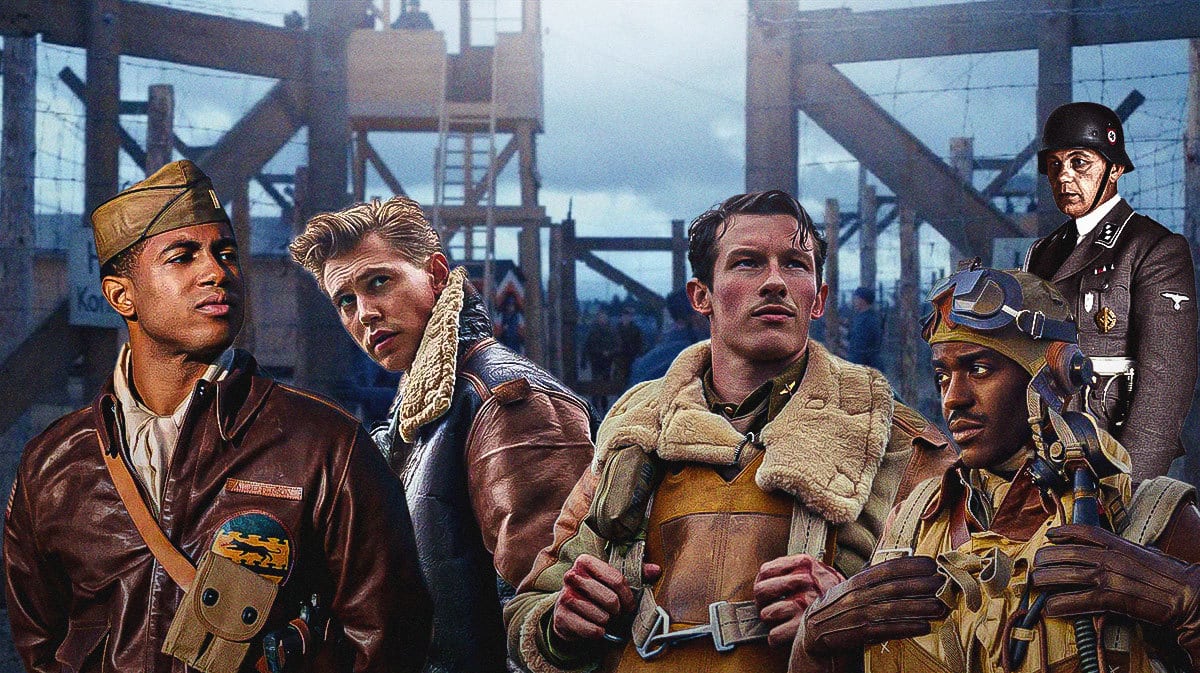The eighth episode of the Apple TV+ miniseries Masters of the Air introduces new characters and pushes key storylines forward as the series comes to a conclusion. The episode is detailed and thorough, alternating between aerial combat, preparations for the D-Day landings, and life at the POW camp as the war turns against Adolf Hitler and Nazi Germany.
Part Eight also covers the contributions and accomplishments of one of the most recognizable African-American units in the US Military during the Second World War, while addressing the racism and segregation that was prevalent in the US Armed Forces.
There is a lot happening here, so let's get into our Masters of the Air episode 8 review and the ending explained.
The Tuskegee Airmen
The penultimate episode of Masters of the Air begins by introducing viewers to the Tuskegee Airmen, the first all-African-American unit of fighter pilots that served in Europe during World War II. The beginning of the episode shows some of the Tuskegee pilots’ early exploits, with exhilarating scenes of the unit carrying out dive bombing operations against Nazi targets.
The men are routinely given the most dangerous missions, and we see them planning an op while knowing they will not have enough fuel to safely return to base.
Crosby successfully plans the aerial assault for D-Day despite burning himself out
Back in England, Crosby is tirelessly preparing for D-Day, the Allied invasion of Europe. Through a voiceover, he explains that he stayed up for more than 3 days. During this brutal stretch, a combination of stress, tiredness, anxiety, uppers, and a sense of duty to have his unit prepared leads him into a delirious mental state.
He is eventually ordered to rest and ends up blacking out. When he awakens, an amused Rosenthal shares that he slept through the entire D-Day operation, but that it was a resounding success and that Crosby deserves credit for his impeccable planning.
Conditions are deteriorating for the POWs
We are then taken to Stalag Luft III, where Bucky Egan is starting to reach his breaking point in captivity. He eventually comes to blows with Buck Cleven, only for the German guards to order the prisoners back into their barracks. The men realize something has happened, but they're not sure what it is at this point.
Shortly after, they learn about the Allied invasion of Europe, along with the Red Army beginning its push into Nazi Germany itself. The men realize that they must prepare themselves for all scenarios, including a forced march deeper into Nazi territory or mass execution at the hands of their SS guards, who took over all prisoner camps after the Normandy invasion.
The Tuskegee Airmen attack German targets in France, and many of them are shot down. After interrogations with Luftwaffe officers, many of them are sent to Stalag Luft III.
Here, despite being American airmen, the Tuskegee pilots generally receive a cold welcome from their fellow POWs. After a while, though, Buck sees the work that Second Lieutenant Alexander Jefferson is doing on plotting an escape route and he starts to befriend him.
Overall thoughts on this episode
Overall, Part Eight is a strong addition to Masters of the Air that speeds up the show a bit after a few slower episodes and sets the stage for the heart-pounding final episode.
I would be lying if I said I didn't have any concerns leading up to this episode about whether the writers would treat the story of the Tuskegee Airmen with the dignity, respect, care, and attention to detail that their history deserves. Fortunately, the episode has eased my concerns, at least to this point.
For viewers who were worried that the show would gloss over the contributions of the Tuskegee Pilots and shy away from addressing the racism that they still faced, we got some scenes that addressed these problems.
Early in the episode, the pilots are discussing how most of them are junior officers, mostly second lieutenants or first lieutenants. This is despite the fact that they have logged a nearly equal amount of flying time to the white pilots who have been promoted to captains, majors, and colonels.
Truthfully, the Tuskegee Airmen deserve their own series, and to be pigeon-holed into the last two episodes stinks of tokenism just to say they were represented, rather than truly giving their story the time and attention it deserves.
This doesn't seem like genuine inclusion, and hopefully the flyers of the “Red Tails” will get their own series soon that does their experience justice.
We also see the overall tension build at the POW camp, although it is more fast-paced than it was in the previous two episodes. Prisoners realize that Allied forces are closing in, and while this could theoretically mean they are close to being liberated, it could also mean the Nazis will sense the walls are closing in and seek retribution against the prisoners.
This episode again shows how the hierarchy and chain of command remained intact even in POW camps. The show depicts the senior officers planning how best to keep the men under their command trained and physically healthy for a potential fight against their German guards.
Part Eight has done the best job of any episode in this series in terms of combining the slower, tense elements of the middle episodes with the well-choreographed aerial combat scenes of the early episodes. While I personally enjoyed the middle episodes, they weren't for everybody.
This episode had something for everyone, and it did a strong job of positioning the series for its conclusion. Part Eight was a very balanced episode, and we will see what happens to the prisoners at Stalag Luft III next week in the final episode, along with the last missions of the war for the Bloody Hundredth.


















